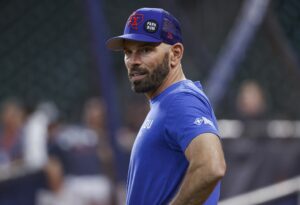The Cincinnati Reds came into the season with a roster that didn’t garner much respect. It’s saturated with place-holders and aging vets. Cincinnati carries a starting rotation which was serviceable at one point, and fell apart before the season even began. Veteran starter Scott Feldman was signed as a depth arm and eventual swing-man as prospects showed up. Yet, he was the one with the ball on Opening Day.
Scott Feldman Pitching to Expectations in Cincinnati
Anthony DeSclafani and Homer Bailey were the ones to keep the rotation together. Bailey began the season on the 60-day DL, as February served him a surgery to remove bone spurs. Desclafani was introduced to the 60-day DL as well with a UCL sprain as spring ball expired.
Opening Day arrived, and it was Feldman with the most complete resume. You’d be lying if you said you expected much from him. His first round on the mound in 2017 lasted just 4.2 innings. Running into trouble early, Feldman surrendered seven hits, including two home runs. He walked two and struck out six on the way to three earned runs on 99 pitches. The Reds fell to the Philadelphia Phillies 4-3.
After a lackluster start to the season, Feldman came back on April 9 with an eye for a win. It was a tough one against Carlos Martinez, staff ace of the St. Louis Cardinals. Feldman’s second start lasted six innings of four-hit play, with a walk and six strikeouts on 101 pitches. The Reds topped the Cardinals 8-0 to take the three-game set.
April 14 was Scott Feldman’s next showing for Cincinnati. This match-up was against Tommy Milone of the Milwaukee Brewers. Their performances were similar, but Milone edged Feldman. Feldman’s five-inning start was ruined oby two runs crossing the plate against him, with the help of four hits and five walks against just three strikeouts. Milwaukee took the game 10-4.
What Has Been is What Will Be
Scott Feldman has a track record of moderate workloads. He’s never been a 200-inning pitcher. Three seasons saw him top the 180 mark. In the past, his pitching style never let him get very deep into games and put up breathtaking stat lines. This will continue.
Feldman has reinvented himself many times in his career. He currently throws a lot of cutters, sinkers, and curve balls. He still doesn’t throw very hard, but this year he has seen a rise in strikeouts and an immense drop in ground balls. Here’s where it gets different.
So far, it seems that Scott Feldman has turned himself from a pitch-to-contact, ground ball pitcher, to a moderate strikeout starter who uses command, movement, and sequencing to limit damage. This is a new Scott Feldman. His 2015 and 2016 seasons were marked by 48.9 and 49.8 percent ground ball rates, respectively. The rate has dropped to 33.3 percent through three starts in 2017.
There are more fly balls and line drives as a result, obviously. This will inevitably lead to more hits and probably a higher hard contact percentage. Essentially, he’s less boring, but just as effective as he’s ever been.
Main Photo:






